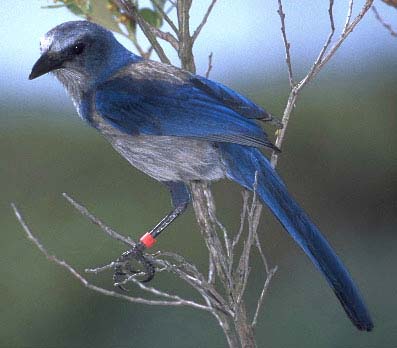Scrub-jay (Genus Aphelocoma) - wiki Aphelocoma
From Wikipedia, the free encyclopedia
[Photo] Florida Scrub-jay, Aphelocoma coerulescens
The passerine birds of the genus Aphelocoma) include the scrub-jays and relatives. They are New World jays found in Mexico, western Central America and the western United States, with an outlying population in Florida. This genus belongs to the group of New World (or "blue") jays - possibly a distinct subfamily - which are not closely related to other jays, magpies or treepies (Ericson et al, 2005). They live in open pine-oak forests and chaparral scrub habitats.
Systematics
Five species of Aphelocoma are generally recognized nowadays, since two taxa formerly treated as races of A. coerulescens were recently split off as separate species (A. californica and A. insularis); the 3 now separate species differ in color and bill size. They are believed to have evolved in the Pleistocene, and the Floridan species is known to have been recognizably distinct and present in its current range for at least 2 million years (Emslie, 1996). Indeed, the inland and coastal populations of A. californica seem to constitute 2 distinct species too, as might different populations of the Mexican Jay (Rice et al. 2003).
Unicolored Jay, Aphelocoma unicolor ??? southern Mexico east to Honduras
Mexican Jay or Gray-breasted Jay, Aphelocoma ultramarina ??? Sierra Madre Oriental and Sierra Madre Occidental mountains of Mexico, north to southeast Arizona, southwest New Mexico and westernmost Texas, US.
Island Scrub-jay, Aphelocoma insularis ??? Santa Cruz Island off southern California
Western Scrub-jay, Aphelocoma californica ??? coastal western North America from Washington to Baja California
- Woodhouse's Scrub-jay, Aphelocoma (californica) woodhouseii - inland western North America, from Oregon through Texas and south to central Mexico
Florida Scrub-jay, Aphelocoma coerulescens ??? Florida
mtDNA NADH dehydrogenase subunit 2 sequence data (Rice et al. 2003) is unable to properly resolve the relationships of the species. Judging from New Wold jay biogeography, the Unicolored or Mexican Jays might represent the most basal lineage; morphology would tentatively lean towards the latter which retains more of the group's color patterns, while the available molecular data allows no robust conclusions whatsoever. In any case, the data of Rice et al. (2003) suggests - albeit also with very low confidence - that the Mexican Jay is comprised of 2 clades which might constitute different species. However, far too few individuals have been sampled to say anything definite on that matter, except that the lineages - if they indeed exist - do not correspond to the geographical pattern of intraspecific variation (see species article for more).
On the other hand, it is somewhat more likely that the Western Scrub Jay is made up of 2 species. These would be separated by the Rocky Mountains, with the Pacific coastal lineage (California Scrub-jay) and the Island Scrub-jay, as well as the inland lineage (Woodhouse's Scrub-jay) and the Florida Scrub-jay being sister species. What is known about the paleogeography of North America supports these findings, but they must be considered preliminary pending analysis of much more data (Rice et al. 2003). Nonetheless, it is actually because the molecular diversity pattern is so badly resolved that it supports the view that rapid Late Pliocene radiation of the North American Scrub-jays led to the present diversity.
Appearance
Aphelocoma jays are slightly larger than the Blue Jay and differ in having a longer tail, slightly shorter, more rounded wings, and no crest on the head. The top of the head, nape, and sides of the head are a rich deep blue. Some species have a white stripe above the eye and dark ear coverts. The breast is also white or grey-white and the back is a grey-brown contrasting with the bright blue tail and wings in most species. One species, Unicolored Jay, is blue all over, superficially similar to the Pinyon Jay from much further north. The bill, legs, and feet are black.
Behavior
Food is taken both on the ground and in trees. Acorns and pine nuts are the most important foods, making up the great bulk of the diet, with grain, berries and other fruits making up the rest of the vegetable diet. Many insects and other invertebrates are also taken, and eggs and nestlings, small frogs, mice and reptiles.
Wild Aphelocoma jays are frequent visitors at campsites and picnics and have frequently learned to eat from the hands of people where they have become accustomed to being fed.
The nest is in a tree or a bush, sometimes quite low down. The nests are compact and lined with hair and fine roots with an outer diameter of about 30cm to 60cm. Usually 2 to 4 eggs are laid and incubated over 14 to 16 days. There are two main variations of egg shell color: green with olive markings or a paler background of grayish-white to green with red-brown markings. The Florida Scrub-jay and the Mexican Jay both have cooperative breeding systems involving several 'helpers' at each nest, usually siblings of the main pair.
Aphelocoma jays are quite vocal and have a huge range of sounds and calls; common calls include a cheek, cheek, cheek and a guttural churring krr'r'r'r'r. Aphelocoma jays are also, like all other jays, often quite aggressive at feeding areas, and sometimes regarded as a nuisance.
Etymology
Aphelocoma, from Latinized Ancient Greek aphelo-, "soft" (Ancient Greek: apalos, απαλ????) + Latin coma "hair", in reference to the smooth plumage of birds of this genus compared to other corvids.
http://en.wikipedia.org/wiki/Aphelocoma
| The text in this page is based on the copyrighted Wikipedia article shown in above URL. It is used under the GNU Free Documentation License. You may redistribute it, verbatim or modified, providing that you comply with the terms of the GFDL. |
